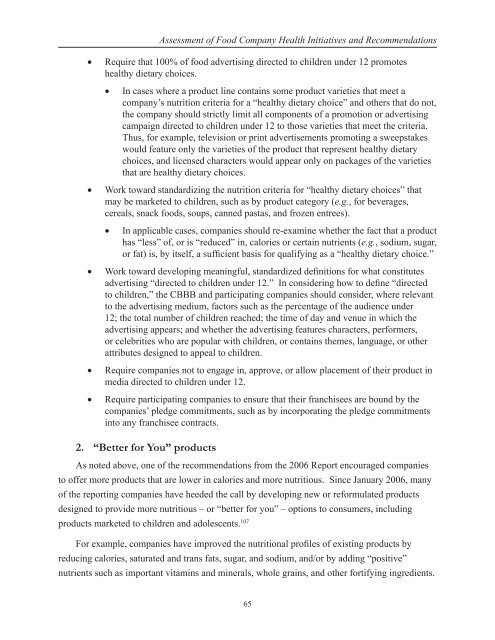Marketing Food to Children and Adolescents - Federal Trade ...
Marketing Food to Children and Adolescents - Federal Trade ...
Marketing Food to Children and Adolescents - Federal Trade ...
Create successful ePaper yourself
Turn your PDF publications into a flip-book with our unique Google optimized e-Paper software.
•<br />
•<br />
•<br />
•<br />
•<br />
Assessment of <strong>Food</strong> Company Health Initiatives <strong>and</strong> Recommendations<br />
Require that 100% of food advertising directed <strong>to</strong> children under 12 promotes<br />
healthy dietary choices.<br />
•<br />
In cases where a product line contains some product varieties that meet a<br />
company’s nutrition criteria for a “healthy dietary choice” <strong>and</strong> others that do not,<br />
the company should strictly limit all components of a promotion or advertising<br />
campaign directed <strong>to</strong> children under 12 <strong>to</strong> those varieties that meet the criteria.<br />
Thus, for example, television or print advertisements promoting a sweepstakes<br />
would feature only the varieties of the product that represent healthy dietary<br />
choices, <strong>and</strong> licensed characters would appear only on packages of the varieties<br />
that are healthy dietary choices.<br />
Work <strong>to</strong>ward st<strong>and</strong>ardizing the nutrition criteria for “healthy dietary choices” that<br />
may be marketed <strong>to</strong> children, such as by product category (e.g., for beverages,<br />
cereals, snack foods, soups, canned pastas, <strong>and</strong> frozen entrees).<br />
•<br />
In applicable cases, companies should re-examine whether the fact that a product<br />
has “less” of, or is “reduced” in, calories or certain nutrients (e.g., sodium, sugar,<br />
or fat) is, by itself, a sufficient basis for qualifying as a “healthy dietary choice.”<br />
Work <strong>to</strong>ward developing meaningful, st<strong>and</strong>ardized definitions for what constitutes<br />
advertising “directed <strong>to</strong> children under 12.” In considering how <strong>to</strong> define “directed<br />
<strong>to</strong> children,” the CBBB <strong>and</strong> participating companies should consider, where relevant<br />
<strong>to</strong> the advertising medium, fac<strong>to</strong>rs such as the percentage of the audience under<br />
12; the <strong>to</strong>tal number of children reached; the time of day <strong>and</strong> venue in which the<br />
advertising appears; <strong>and</strong> whether the advertising features characters, performers,<br />
or celebrities who are popular with children, or contains themes, language, or other<br />
attributes designed <strong>to</strong> appeal <strong>to</strong> children.<br />
Require companies not <strong>to</strong> engage in, approve, or allow placement of their product in<br />
media directed <strong>to</strong> children under 12.<br />
Require participating companies <strong>to</strong> ensure that their franchisees are bound by the<br />
companies’ pledge commitments, such as by incorporating the pledge commitments<br />
in<strong>to</strong> any franchisee contracts.<br />
2. “Better for You” products<br />
As noted above, one of the recommendations from the 2006 Report encouraged companies<br />
<strong>to</strong> offer more products that are lower in calories <strong>and</strong> more nutritious. Since January 2006, many<br />
of the reporting companies have heeded the call by developing new or reformulated products<br />
designed <strong>to</strong> provide more nutritious – or “better for you” – options <strong>to</strong> consumers, including<br />
products marketed <strong>to</strong> children <strong>and</strong> adolescents. 107<br />
For example, companies have improved the nutritional profiles of existing products by<br />
reducing calories, saturated <strong>and</strong> trans fats, sugar, <strong>and</strong> sodium, <strong>and</strong>/or by adding “positive”<br />
nutrients such as important vitamins <strong>and</strong> minerals, whole grains, <strong>and</strong> other fortifying ingredients.<br />
65

















